
Piperade
I ran out of eggs last week; on a Sunday, in rural France, at 12:35.
If you live anywhere in the commercially throbbing 24/7 part of the globe with a convenient nearby corner store or fuel station supermarket, then perhaps the gravity of this disaster isn’t going to resonate with you, so let me explain.
French lifestyle revolves around food, but if you want to cook the food yourself, you have a limited amount of time each week to buy it. You can buy it in the morning, or, the afternoon—but never, I stress NEVER between the sacred lunching hours of 12:30-3pm, and certainly not EVER after 12;30pm on a Sunday. If you want to buy it online, you can… you just need to get in your car, drive to your ‘nearest’ distribution centre, pack it yourself (into your own bags), then drive home and cart it inside—just don’t try doing this outside the regular business hours mentioned above— the luxury lies purely in the elimination of pushing a trolly.
Imagine now if you will, the expletives that ricocheted around the interior of my egg-less fridge as I reached inside on a mission to bake 2 dozen cupcakes for Monday’s school bake sale. There were also a few expletives directed towards the stalled construction of our hen house, however (she takes a sip of chilled white Burgundy and remembers why she’s here) there is a hidden upside to living in rural France; that being— it’s rural. You see, most people within earshot of your frustrated expletives will, in fact, have chickens, possibly ducks, or even both, so with this in mind I refilled my glass and sent the children off to visit our neighbour, Mousier M.
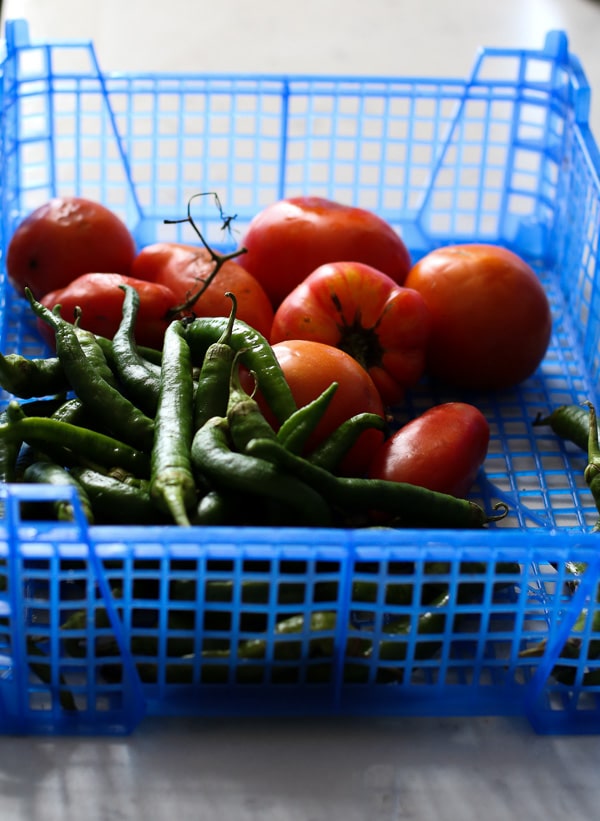
Pointed green Basque Gernika peppers and homegrown tomatoes
What they returned with moments later was not only a dozen eggs (hooray), but a crate of warm sun-ripened tomatoes, freshly picked capsicums and long green Basque Gernika peppers. In fact, what Mousier M had given me, was piperade; a typical Basque meal made with the colours of the Basque flag: red (tomatoes and red Espelette peppers), white (eggs) and green (Gernika peppers). The perfect lazy Sunday lunch.
Preparing a piperade is actually quite simple, although if you want to know how NOT to do it, there’s a very entertaining clip from Keith Floyd’s BBC food series which I encourage you to watch in advance. Click here.
If by now you’ve watched the Keith Floyd clip, and I really hope you have, then you’ll realise that what I’m about to describe is not exactly a piperade, but an adaptation of one.
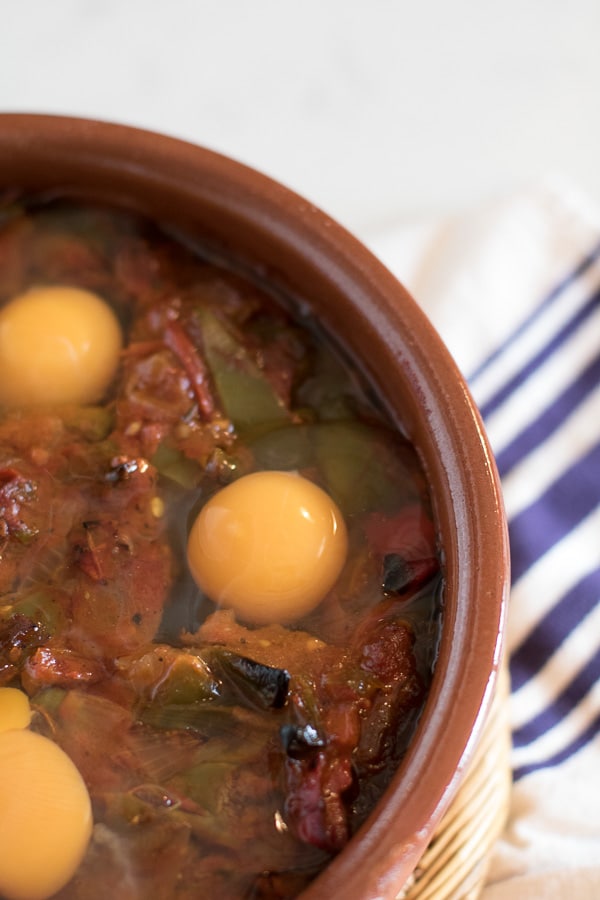
The Piperade departure-instead of adding beaten egg, I nestle whole eggs into the sauce to bake in a traditional Cazuela (earthenware dish)
My version of the piperade is mostly traditional up to the point of cooking the onions, peppers and tomatoes on the stove in a frying pan. From there on, it goes a little off-piste. Rather than add beaten eggs, I bury mine whole in little wells within the sauce to gently poach. I also prefer to develop the flavours a little further in the oven before I do this.
Once the vegetables are cooked, I place them in an earthenware cazuela, a shallow Spanish casserole dish. If you don’t have one, just use a shallow casserole dish without a lid. Slowly roast the vegetables in the oven on a moderate heat until they start to colour ever so slightly on top and the sauce is nicely thickened. At this point, you have a typical Basque or Béarnaise Piperade sauce which can be used to accompany meat, poultry or fish. You could also allow the sauce to cool and then refrigerate it until you’re ready to cook the eggs, which makes for a super quick and delicious weeknight dinner.
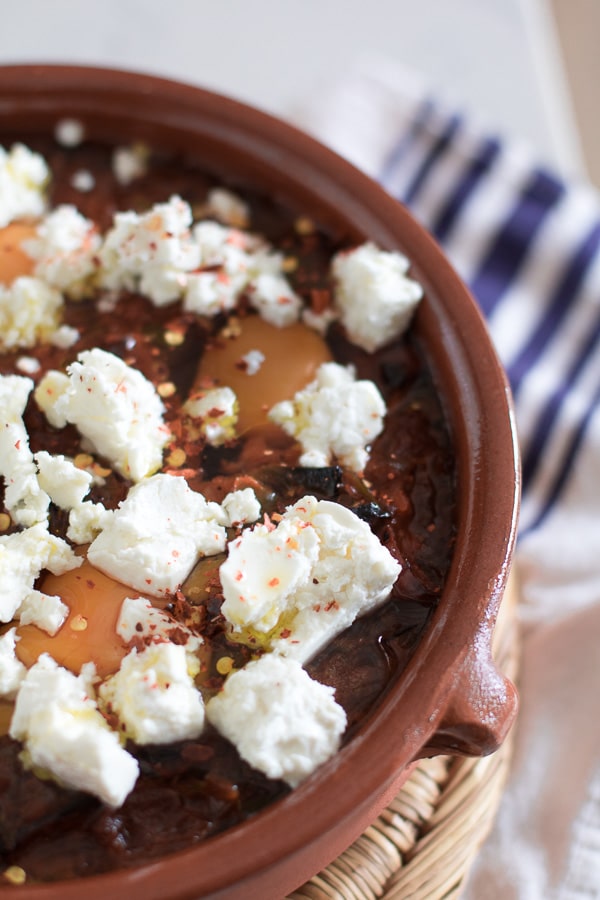
When you’re ready to cook the eggs, make small indentations into the sauce and crack as many eggs as you need per person; 1-2 is usually sufficient. Sprinkle with broken feta (I use the local sheep’s milk feta) and chilli flakes, then bake in the oven until the feta is slightly golden on top and the eggs yolks are still runny. The finished dish is very much like a Shakshuka, but with a uniquely Basque flavour.
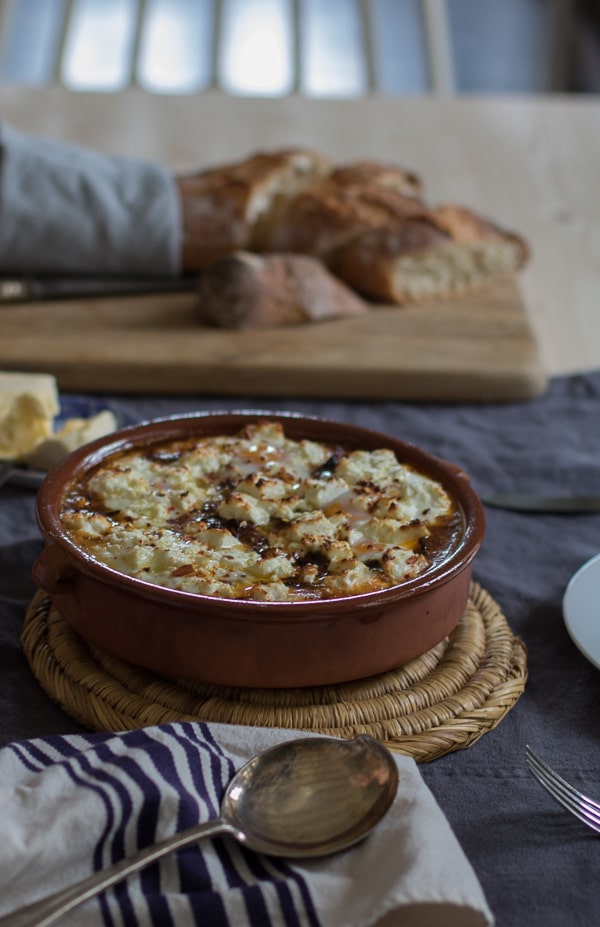
Baked Piperade, with crunchy baguette and beurre doux; creamy unsalted butter from Normandy.
All that’s required after you pop it on the table is a crunchy baguette and, as Keith Floyd used to say, ‘there you have it’. Throw your apron over one end of the kitchen table and enjoy. It truly is one of the easiest and most delicious late summer or autumnal lunches.
As with any simple dish like this, quality ingredients are key, so make sure you source the very best sun-ripened tomatoes, peppers and free range eggs you can find.
In fact… it’s probably best to make it on a Sunday when the only ingredients available come straight from the farm gate!
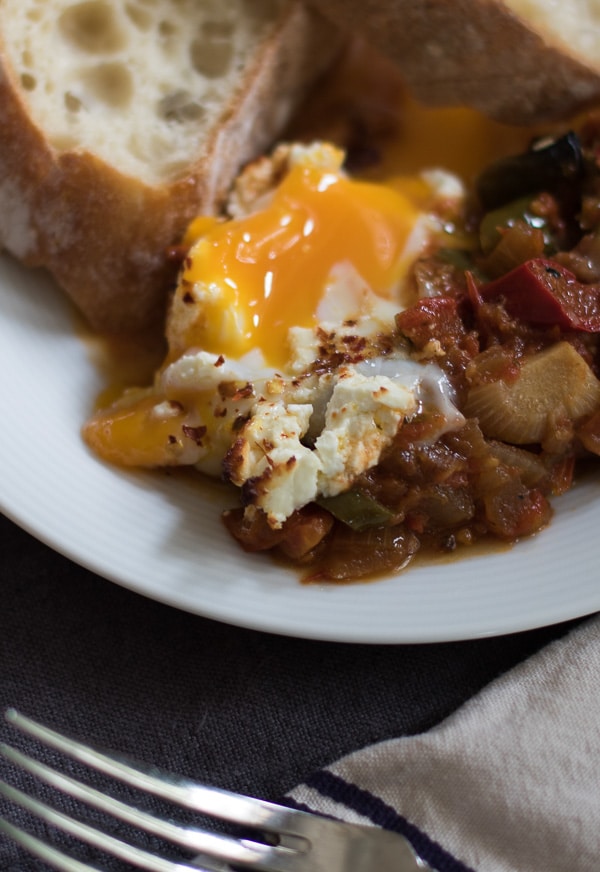
The finished dish, with its gloriously golden runny yolks
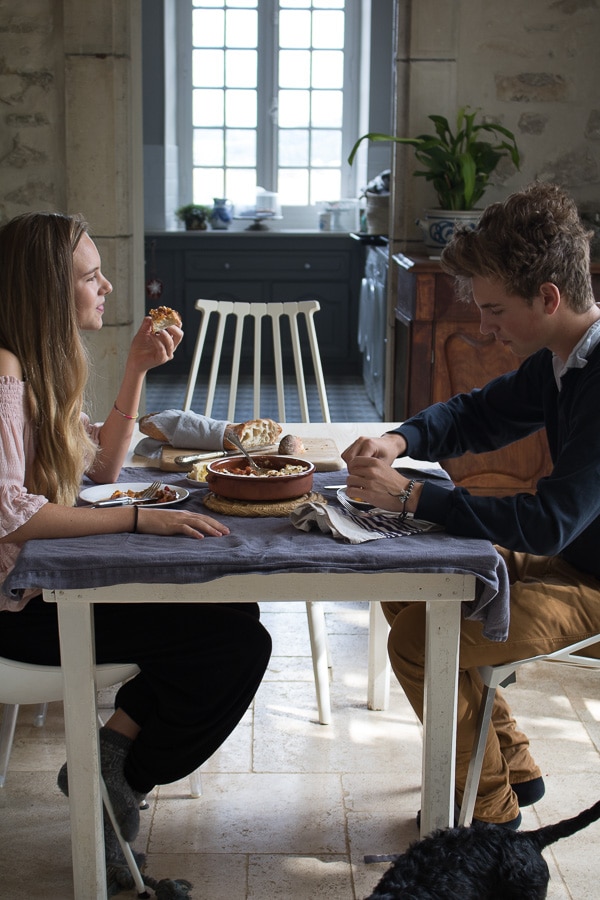
Annabelle and Hugo, enjoying their Piperade with Stanley taking care of the crumbs

Stanley, chief floor mopper upper
Recipe
Ingredients:
For the Piperade:
-
2 tablespoons olive oil
-
1 large onion, thinly sliced
-
1 red bell pepper, thinly sliced
-
1 green bell pepper, thinly sliced
-
2 cloves garlic, minced
-
2 medium tomatoes, chopped
-
1 teaspoon piment d’Espelette (or smoked paprika)
-
Salt and freshly ground black pepper, to taste
For the Baked Shakshuka with Feta:
-
4 large eggs
-
100g feta cheese, crumbled
-
Fresh parsley or basil, chopped, for garnish
-
Crusty baguette, for serving
Instructions:
-
Prepare the Piperade:
-
In a large skillet or sauté pan, heat the olive oil over medium heat.
-
Add the sliced onions and bell peppers. Cook, stirring occasionally, until softened, about 5-7 minutes.
-
Stir in the minced garlic and cook for another minute until fragrant.
-
Add the chopped tomatoes and piment d’Espelette. Season with salt and pepper.
-
Reduce the heat to low, cover, and let the mixture simmer for 10-15 minutes, allowing the flavors to meld.
-
-
Assemble the Baked Dish:
-
Preheat your oven to 375°F (190°C).
-
Transfer the piperade mixture to a baking dish or keep it in the skillet if it’s oven-safe.
-
Make four small wells in the piperade mixture.
-
Carefully crack an egg into each well.
-
Sprinkle the crumbled feta cheese evenly over the eggs and piperade.
-
-
Bake:
-
Place the baking dish in the preheated oven and bake for 12-15 minutes, or until the egg whites are set but the yolks remain runny. For fully set yolks, bake an additional 3-5 minutes.
-
-
Serve:
-
Remove from the oven and let it cool for a few minutes.
-
Garnish with chopped fresh parsley or basil.
-
Serve warm with slices of crusty bread for dipping.
-

Surely your models aren’t paid and get to eat the delicious food as well. Seriously fantastic photos
Hello, What a gorgeous website! I have just started a blog too (though I have blog theme envy now!). We are renovating in SW France as well, and my blog is aimed at encouraging and inspiring girlies, like me, living in house renovation chaos. Good luck with your’s, and if you fancied a peek of mine, I’m at http://www.aperogirl.com. Bon courage x
Thanks so much for touching base Anna! I had a look at your blog and it looks like we could swap lots of stories on the delights of living ankle deep in dust! Keep up the great work. I’ll look forward to your next instalment!
Thank you Sara, I’m sure we could! We are a very special breed us French wreck restorers, aren’t we? Your photos and recipes are gorgeous. I look forward to checking in again. Take care x